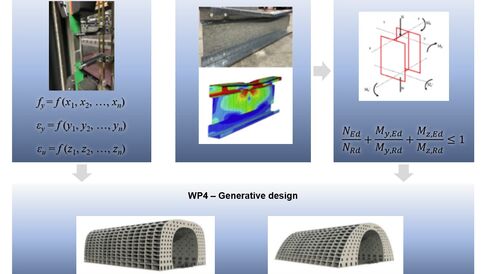RESTOR
REUSE OF STRUCTURAL STEEL IN CONSTRUCTION (RESTOR)
The steel industry is a major contributor to greenhouse gas (GHG) emissions, and the construction industry heavily relies on steel structures. Therefore, the research challenge is to develop innovative technical solutions that maximize the sustainable, efficient, and low-energy reuse of structural steel. The project will contribute to reducing GHG emissions, achieving low carbon and net-zero targets, lowering waste streams and costs, and diversifying the construction industry by providing digital technology opportunities.
The environmental impact of steel buildings can be significantly reduced and promote a more sustainable and efficient use of resources by reusing steel members instead of recycling them. RESTOR will utilize advanced non-destructive testing (NDT), machine learning optimization, and building information modeling (BIM) techniques to enable the reuse of structural steel, while delivering economic and societal benefits. The RESTOR project will be organized into five work packages (WPs), each focused on specific objectives and tasks. The WPs are as follows:
WP1: Material Characterization
This WP aims to develop mathematical models for the material properties of used steel members based on NDT measurements. The models will consider a wide range of steel grades and pre-existing damage conditions. Experimental tests and NDT measurements will be conducted to calibrate and validate the mathematical models.
WP2: Performance of Used Steel Members
This WP will verify the structural performance of used steel members through experimental studies. The structural behavior of the members will be studied and advanced nonlinear finite element models will be developed and validated. The results will inform the optimized design process in WP3.
WP3: Machine Learning-Based Optimization
This WP will focus on developing a novel optimization method for repurposing and structurally designing used steel members. The method will consider member residual life, damaged material properties, and smart repurposing strategies. Machine learning-based optimization techniques, such as evolutionary algorithms, will be employed to solve the repurposing problems. The objective is to minimize embodied energy and maximize the utilization of structural capacity.
WP4: Generative Design Tool
In this WP, a web-based generative digital twin design tool will be developed to support the generative design of new buildings made of used steel members. The tool will integrate the mathematical models from WP1, the structural performance data from WP2, and the optimization method from WP3. It will enable stakeholders to generate automated building configurations using used steel members, ensuring optimized design and validated performance.
WP5: Dissemination and Exploitation
This WP will ensure effective project management, coordination, and dissemination of research findings.

